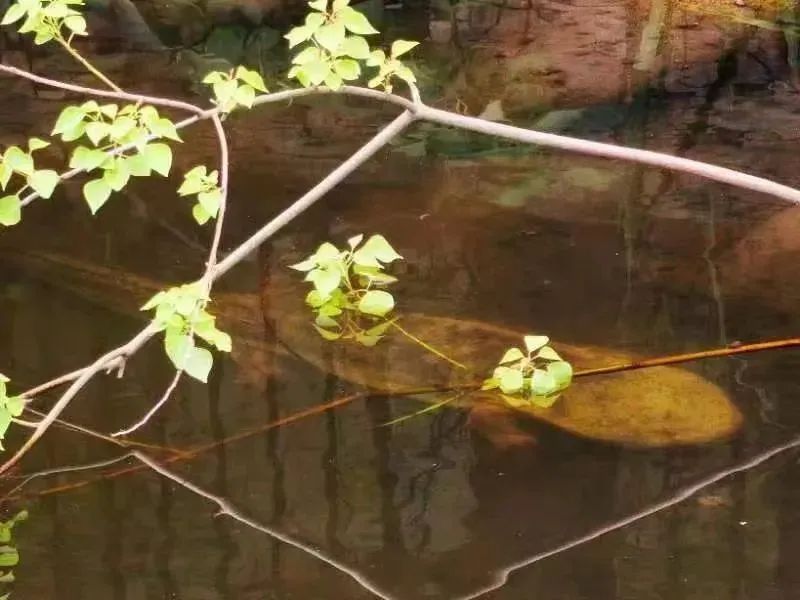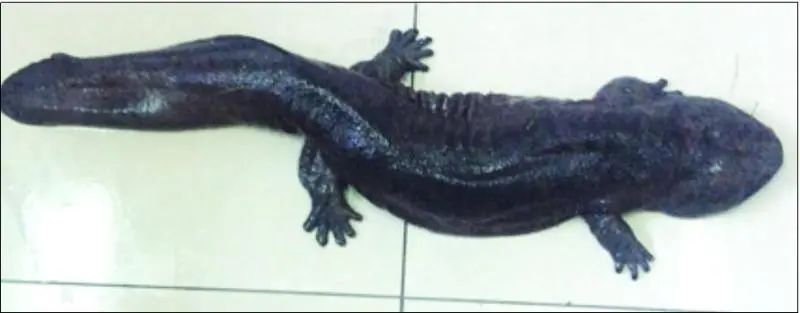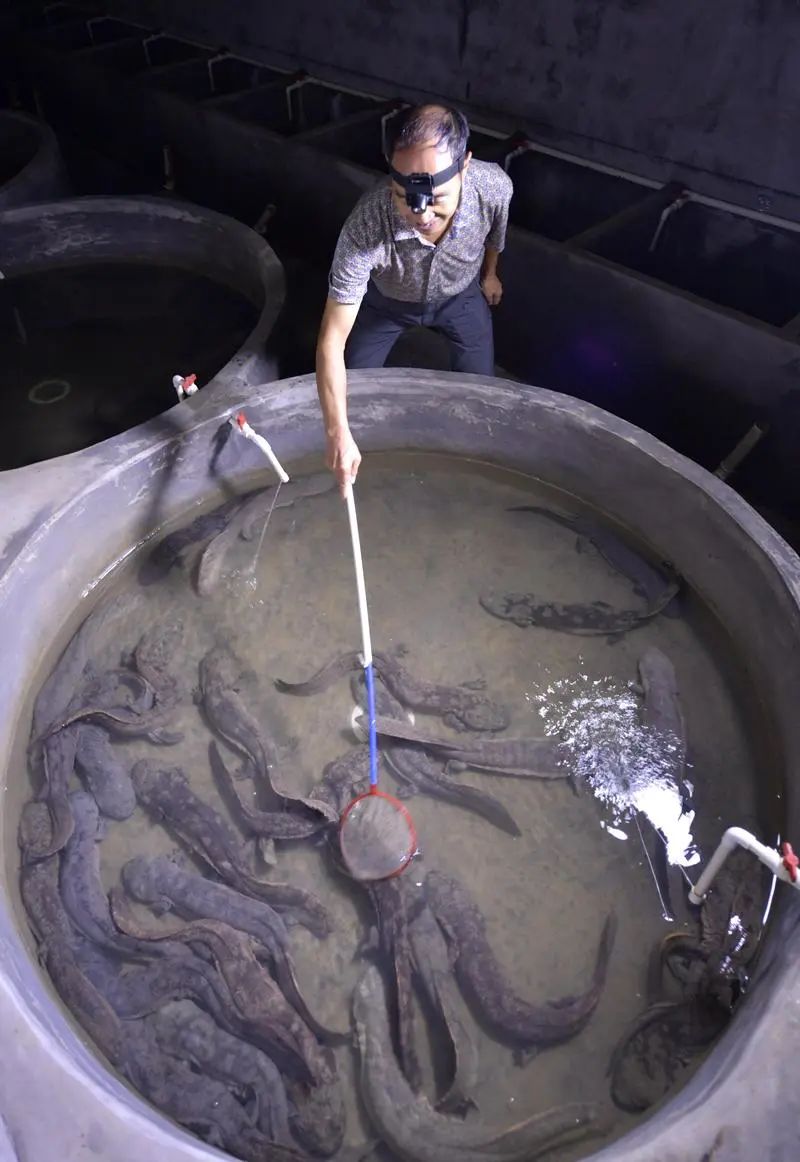The "four -legged fish" in Shanghai Park!The body is brown, the front and rear limbs are clearly visible to the toes ... the picture is exposed →
Author:Look at the news Time:2022.08.12
Recently, a rare "four -foot strange fish" appeared in the Shanghai Wusong Cannon Taiwan Wetland Park.

"Living fossils" that can swim
At the end of last month, Ms. Wang, who lived in Baoshan District, found that there was a "stone" in the lake during the morning run. Take a closer look. toe. Ms. Wang quickly took the video and photos and ran to the park management office to inquire.
I learned that I saw the Chinese Da Da, Ms. Wang was very happy: "It feels that it has seven or eight pounds, fat, very cute, rare to see, so lucky."
For Ms. Wang's discovery, the garden side was very "calm". Administrators said that in fact, since last year, some people have discovered suspected of being suspected of Chinese Dali in this water. Daji picture.


Picture source: Shanghai Baoshan
The garden party said that it will be carried out on the spot, continuous follow -up and recording its status of the Chinese Daibi.
China's Dajie is a rare wild animal unique to China. Comparing fossil records can be found that in the past 160 million years, the body structure of China's Dajiu has not changed significantly, and has extremely high evolutionary uniqueness. It has occupied an important position in the protection of global biodiversity resources. Therefore "".
China's Dajie plays the role of top predators in the freshwater ecosystem, which has an important influence on the ecosystem from top to bottom, maintaining the stability and balance of the ecosystem.
Some studies have pointed out that from 1978 to 1999, the Chinese large -scale groups in China were widely distributed in my country's Yellow River Basin, the Yangtze River Basin, the midstream of the Pearl River Basin, the upstream areas and its tributary of the freshwater ecosystems. Downstream, there are 205 counties and cities in 17 provinces, cities, and autonomous regions including central, southern and southwest of my country.
However, from 2000 to 2019, the distributed counties and cities of the Dashuo fields in China continued to decline to only 38, and its distributed county area dropped to 16.2%from 1978 to 1999.
The rapid increase in hydropower facilities in the habitat, the increased water pollution caused by sand digging, domestic waste and sewage discharge, pesticide and chemical fertilizer residues, and the abuse of food is the main factors that have caused the sharp decline in population resources in China's large fields in China.
Therefore, Chinese Dajie has become the flagship species of amphibious protection in my country. In 1988, my country's "Wildlife Protection Law" listed China as a national second -level key protection wildlife. In 1998, the Chinese Dairy was listed as a very critical (CR) species by the "Red Book of Endangered Animals in China".
"Doll Fish" has been a ghost many times
Regarding the reasons for the emergence of Chinese big sturgeons, many experts told Jiefang Daily · Shangguan News reporters that there is no wild Chinese large -scale distribution in Shanghai, and it is likely that people outside the garden secretly release or escape from the artificial breeding environment in the garden.
The reporter checked the information and found that Wusong Cannon Taiwan Wetland Park recorded that it was not Shanghai's first case in China. Earlier, Shanghai had a lot of records of Chinese big sturgeon.
In the early morning of May 1, 2014, a Chinese Da Da was found on the auxiliary road at the entrance of the Western Morlon in Minhang. The Chinese big sturgeon was hot, and it was jumping again, and even bite a community security pants. After receiving the alarm, the police rushed to the scene and joined hands with the security guard. It took more than half an hour before he carefully dialed it to the carton, and was taken away by the staff of the Shanghai Zoo.

That hot "baby fish" picture source: Minhang Public Security
In February and November 2015, the citizens in Songjiang District and Jinshan District caught China in the local waters. The former was more than 30 cm long and weighing about 2.3 kg. After coming up, they are handled by professionals.
In November 2015, some residents found a Chinese dumplings about 60 cm in length in a grass bush in Jiading. After driving them into the plastic box, no matter how they change water, feed fish and feed, they ignore it. Jump up from time to time. The next day, the agricultural department of Jiading District sent the "Storm" China Great Great Great Land to a breeding base for protective reservation.
In June 2018, when the moss water plants in the moss in the pit garden garden garden garden garden in Shanghai, the moss water grass near the lake was cleaned up unexpectedly. I took a few photos for it, and I felt that it was "frightened", so I quickly put it back to the deep part of the lake.

"Baby Fish" motionless, seemed to be afraid, Chenshan Botanical Garden Gardening Workers quickly put it back to Wang Zhengwei and Yang Wanyun in the lake.
Researchers in Chenshan Botanical Garden believe that this Chinese Dajin is likely to be released. As for when it is released, there is still controversy.
Some people think that the water temperature in Jinghu in the summer is high, and the Chinese Daiya, who likes low temperatures, has a low survival rate in it, so this Chinese Daji is likely to be released into the lake earlier that year; The deep -water area covered by the bridge, even if the water temperature in the summer is very low, the Chinese dumplings may have been "lurking" in the lake for several years.
Be sure to think twice before the release of animals
"Rich species is a good thing, but we don't want this richness to be generated by release." Chenshan Botanical Garden experts pointed out that unscientific and irregular releases will harm the release of animals and even cause the ecological environment to cause the ecological environment Negative impact.
Taking the Chinese Dajie as an example, the lake area of Wusong Cannon Taiwan Wetland Park and Chenshan Botanical Garden seems to be very ecological environment, which is very suitable for China Daji, but it is not. Judging from the characteristics of the distribution area of the gauge species, the habitat of the wild Chinese big sturgeon is mostly located in the upper reaches of the river stream. Generally, it is distributed in the mountains on the edge of the basin. The water depth is low, there are many sand and gravel in the river bed, and the surrounding vegetation coverage is high.
This natural life realm determines that China's big sturgeon has quite high requirements for environmental humidity, water quality, and water temperature.
The environmental humidity of the survival of China's Daji is higher than 80%, and the water temperature changes range from 5 ° C to 25 ° C. The water bodies with a slow water flow rate, clean food resources (mainly stream crabs, fish and shrimp, etc.) and high -dissolved oxygen content The environment is more sensitive to the acid and alkali of the water body. The pH value of the habitat water body is 6.5 to 8.63, and the total hardness is 120 mg/liter to 174 mg/liter.
The breeding base of Huayuan Dazhen, Huayuan County, Hubei Province, through quoting the construction of the "groundwater" circular system, creating a picture of imitation natural ecological environment pictures that are suitable for big puppet breeding: Xinhua News Agency

Faced with so many requirements, many lakes in Shanghai's parks are difficult to reach. Relevant experts said that especially in temperature, the hot summer and cold winter in Shanghai, the water temperature is difficult to stabilize at 5 ° C to 25 ° C for a long time, and it is difficult to reach the level of Qingxi in the mountains.
According to reports, the Chinese Dai Dai discovered by Chenshan Botanical Garden in 2018 has not appeared after 2018, and it is likely that it has died because it cannot adapt to the temperature of the lake.
The release of a Chinese downturn can not play any positive effect on restoring its field population. Studies have shown that in recent years, most of the population density in the protected areas distributed in China is below 1/kilometer, let alone Shanghai, which is distributed in the universal Chinese large Chinese. To "compatriots".
The influence of large -scale discharge on China may not be positive. According to incomplete statistics, as of the end of 2020, the number of Chinese Dalong's release has exceeded 270,000. Although in the number of fields in the wild, it has played a certain protective role, but the protection of most protected areas is not obvious, and the survival rate of proliferation and discharge is also low.
In addition, because the genetic background of the returnees is unclear, the return individuals of some protected areas may not be derived from the local genetic branch. The advantage and competition with local populations have caused the risks of native small population to exacerbate.
Flow "Baby Fish" Picture Source: Xinhua News Agency

In recent years, the "release" activities of spontaneous organizations of citizens and social groups have increased, and some of the release effects that do not understand the survival conditions of wild animals are also counterproductive. For example, release foreign species such as Brazilian turtles, bullfrogs, and Qingdaofu may break the original ecological balance of the local area.
Taking Qingdao Fish as an example, their habits are to absorb algae, benthic animals, etc. If they reproduce a large amount in the wild, they may devour other fish eggs, and even cause local native fish to extinct where the water system is located.
For another example, release hybrids such as koi and hematopoietic silver may cause mixed fish genes and degeneration of natural waters; release fierce fish such as black fish and birds, etc. The survival of fish.
Liberation Daily · Shangguan News Original manuscript, reprinting without permission
Author: Chen Xihuan
WeChat editor: Miss Pi
- END -
The problem of the accumulation case solve the problem and the problem of the "mass work from the door"

Original title: abide by the people's feelings for the people -the letter and visi...
Wenshan Prefecture Meteorological Observatory issued a strong pair of yellow warning [Class III/heav
Wenshan Prefecture Meteorological Observatory continued to issue a strong pair of yellow warning at 0:82 on June 9, 2022: It is expected that in the next 12 hours, Wenshan, Laoshan, Xichou, Maliguan,